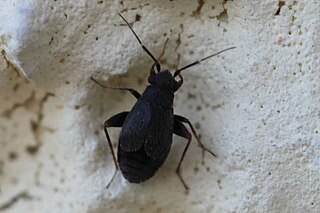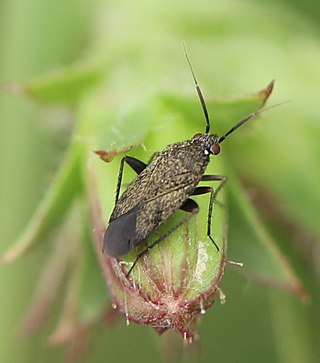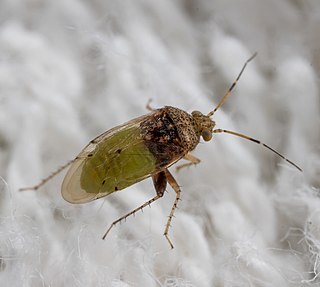
The Miridae are a large and diverse insect family at one time known by the taxonomic synonym Capsidae. Species in the family may be referred to as capsid bugs or "mirid bugs". Common names include plant bugs, leaf bugs, and grass bugs. It is the largest family of true bugs belonging to the suborder Heteroptera; it includes over 10,000 known species, and new ones are being described constantly. Most widely known mirids are species that are notorious agricultural pests that pierce plant tissues, feed on the sap, and sometimes transmit viral plant diseases. Some species however, are predatory.

Macrotylus is a genus of plant bugs in the family Miridae. There are at least 60 described species in Macrotylus.

Phylinae is a subfamily of the plant bug family Miridae. Species of this family are found worldwide.

Pilophorini is a tribe of plant bugs. The type genus is Pilophorus. Schuh's analysis indicates that the Pilophorini originated in tropical Gondwanaland and subsequently spread into the temperate Northern Hemisphere, where they differentiated into the known genera.

Capsus is a genus of mirid bugs belonging to the family Miridae, subfamily Mirinae.

Phylini is a tribe of plant bugs in the family Miridae, based on the type genus Phylus. There are at least 440 described species in Phylini.

Deraeocorinae is a subfamily of plant bugs in the family Miridae. There are more than 40 genera and around 500 described species in Deraeocorinae.

Cremnorrhinini is a tribe of plant bugs in the family Miridae. There are about 50 genera in Cremnorrhinini, all but five in the subtribe Cremnorrhinina.

Macrolophus is a genus of plant bugs in the family Miridae. There are at least 20 described species in Macrolophus.

Chlamydatus is a genus of plant bugs in the family Miridae. There are more than 30 described species in Chlamydatus.
Tuxedo is a genus of plant bugs in the family Miridae. There are about seven described species in Tuxedo.

Lepidargyrus is a genus of plant bugs in the family Miridae. There are about 14 described species in Lepidargyrus.

Ranzovius is a genus of plant bugs in the family Miridae. There are about 10 described species in Ranzovius.

Dicyphus is a genus of plant bugs in the family Miridae. There are at least 70 described species in Dicyphus.

Exaeretini is a tribe of plant bugs in the family Miridae. There are more than 20 genera in Exaeretini.

Nasocorini is a tribe of plant bugs in the family Miridae. There are more than 50 genera in Nasocorini.

Semiini is a tribe of plant bugs in the family Miridae. There are more than 30 genera in Semiini.
Tytthus fuscicornis is a species of insect in the family Miridae. It was first described by Thomas J. Henry in 2012 and is native to California, USA.
















